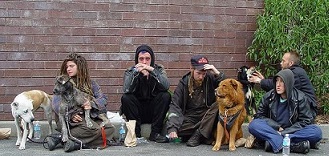by Ann Harrison
Why is the rate of homelessness higher in urban areas than in rural communities?
Studies show that 77 percent of the homeless population is located in large cities, whereas only seven percent of the homeless population comes from rural areas. Although homeless people in farming communities and small towns suffer for many of the same reasons those in urban areas do, the question I present to you today is why the homeless rate is higher in urban areas.
According to a survey conducted by the U.S. Conference of Mayors, homelessness in cities where the cost of living is higher than average, such as Los Angeles and New York, is on the rise, although the homeless population has declined nationwide in recent years. The homeless population is much higher in these cities than in cities such as Houston and Chicago, where the cost of living is lower, due to a decrease in wages and a shortage of affordable housing. With the booming economy in cities such as Washington D.C, Seattle, LA, and NYC, people have been forced from their homes, because the wages they earned fell short of the phenomenal rent increases.
Let’s take a brief look at the statistics that were found as a result of this survey conducted in December of 2015. In Washington D.C. alone, the rate of homeless people increased by 26 percent, while the rate of homeless families rose by 60 percent. However, this survey doesn’t take into account those who either saved enough to rent rooms in cheap hotels, slept in tents, or camped on the couch, or slept on the floor of a friend’s apartment, or moved in with relatives.
However, the U.S. Conference of Mayors found that the rate of homelessness in San Francisco significantly dropped by as much as fifteen percent. Although the reasoning behind this reduction in the homeless population wasn’t specified in the survey results, the Conference of Mayors gave high praise to a city-wide initiative called the Navigation center, for offering temporary housing to San Francisco’s homeless population. While these homeless families are living in these temporary homes, the Navigation Centers puts them in touch with case managers, who can help them find permanent housing solutions.
Now that we have discussed the reason for a higher rate of homelessness in urban areas versus that in rural areas, here are some questions for further reflection and research. Has the homeless population in your town or city risen or declined in the last decade? If there are more homeless people in your neighborhood than ever before, how does your community help those in need find permanent housing?
Sources:
https://endhomelessness.org/resource/rural-homelessness/
About the Author
Ann Harrison-Barnes is the author of three books: A Journey of Faith: A Stepping Stones Mystery, Stories Outside the Box, and Maggie’s Gravy Train Adventure: An Electric Eclectic Book. She has also been published in several anthologies. Aside from her work as a Christian fiction author, Ann is a professional writer and she also crochets bookmarks and book covers to promote her books. To learn more about Ann and her work, visit her website at www.annwritesinspiration.com.



